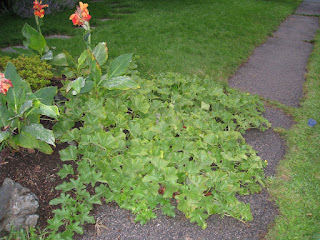In late spring we were at Costco and bought some Cana bulbs -- Child One thought they'd be pretty so we went with her selection. Cana are large, tropical looking plants (the plants in the below photo, with orange flowers). We planted the bulbs in the bed at the front of our house, around our light post and an azalea. I used home brewed compost to fertilize them. Within a short time the bulbs had barely sprouted but something else had burst from the ground -- a volunteer seed in the compost.
At first blush the volunteer appeared to be a squash plant -- the leaf shape and size was right and it had a large yellow flower. It started as one sprout but quickly spread, growing larger and larger. We nearly picked it early on but I got curious to see what would come of it. Once the plant was probably 5 feet from tendril-tip to tendril-tip Mrs. Agricola agreed that we had to see what it was.
The plant in mid-summer glory
The plant shot out shoots from the sprout that grew in opposite directions from each other and soon it started to fill in with more shoots, leaves and flowers. I was fairly convinced that it was a squash, or perhaps a pumpkin and many of our neighbors would swing by and ask us about it -- it was big doings in our section of the neighborhood. By mid-July the thing had taken over nearly half of the bed in which it sprouted. It spread probably 6 feet in length and probably 4 feet from the original sprout area to the tips of its cascade -- it overran the sidewalk. One day, I took a good, close look at the thing and it had several smooth, green, ovoid-shaped fruit hiding within its foliage. I had no idea what they were and picked a large one -- I thought it was some sort of strange, hybridized squash.
Who knew cantaloupes start so smooth?
The one that was picked too early
had hints of cantaloupe flavor and some sweetness
As soon as I picked it and held it close I realized that I had a very large, very healthy cantaloupe plant -- the skin at the end of the fruit was just beginning to take on the appearance of a mature cantaloupe. At the time of the first pick there were 6 other fruits on the vine. The early picked fruit didn't ripen but it's brothers and sisters ripened beautifully and we enjoyed a bumper harvest of homegrown cantaloupes -- all in all we probably harvested 10 melons off of this plant.
I didn't expect much from the cantaloupes -- after all they are from commercial seeds that grew in a bed in a suburb of Boston, many of them ripening on asphalt. I have to say however that these are some of the best melons I've ever eaten. They were juicy beyond belief, sweet and as fresh as you can get. Letting them further ripen on the window sill only made them better (though eating a still sun-warmed cantaloupe is pretty amazing). If ever there was a poster-fruit for eat-local this is it -- picked at the peak of ripeness and carried 50 feet to the kitchen there is nothing better!
Can't beat fresh cantaloupe!
This past weekend we pulled up the plant -- it was starting to recede into itself and looking really funky as it died with oncoming fall. The leaves and stems and flowers that never fruited were recycled in the composter. I saved a bunch of seeds from one particularly good melon and am going to plant one intentionally next year, though those fruit will probably not be able to compare to the cool experience of this year's volunteer cantaloupe.








1 comment:
I've got my money on your home-brewed compost. I think that was the culprit.
What you've described is not only culinary goodness, but also a lesson in patience and curiosity.
Metaphorically speaking, too often in our lives we're in a rush to clear the weeks and uproot what we appear to be the competition. Sometimes, if we bide our time and take an interest in something not normally in our sphere, some amazing results can flower.
Post a Comment